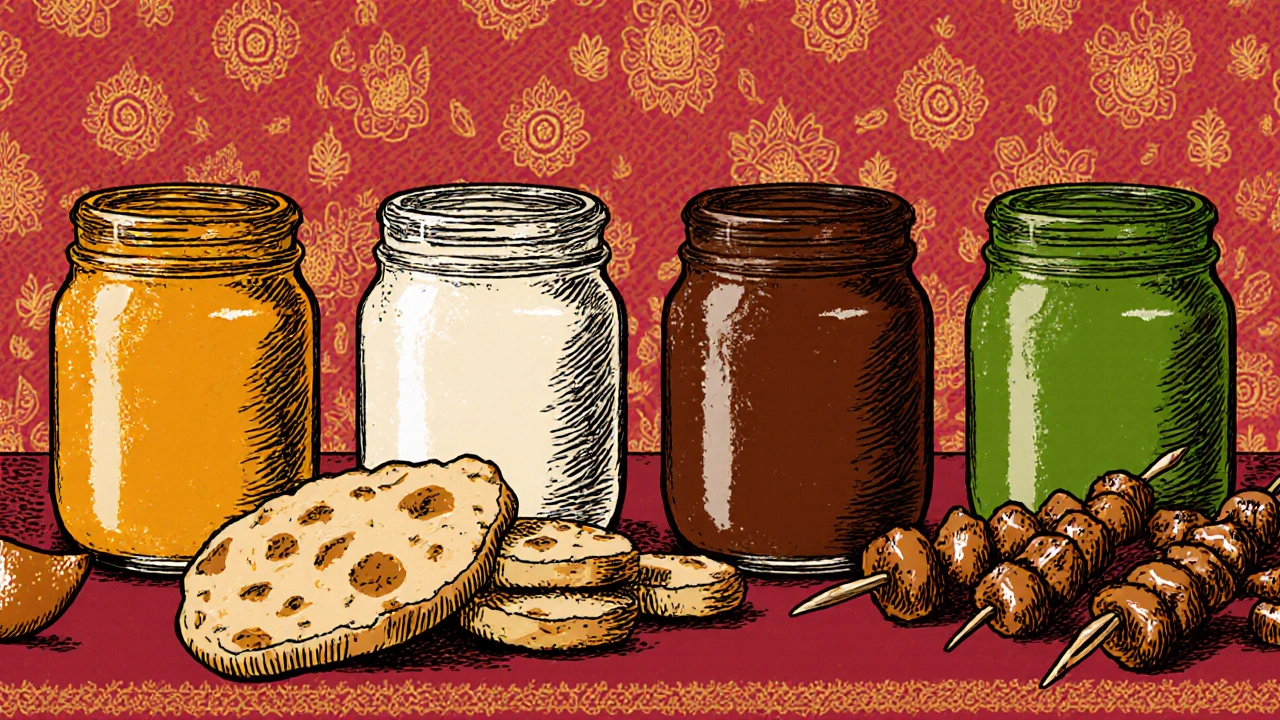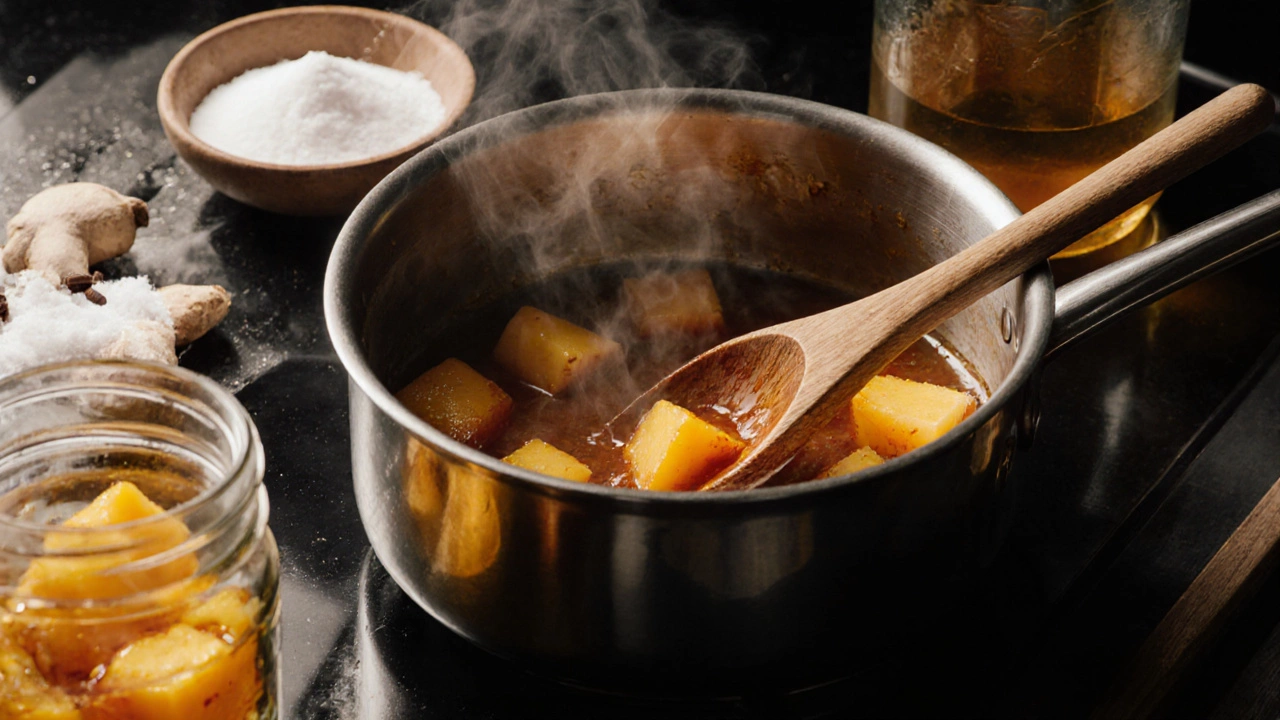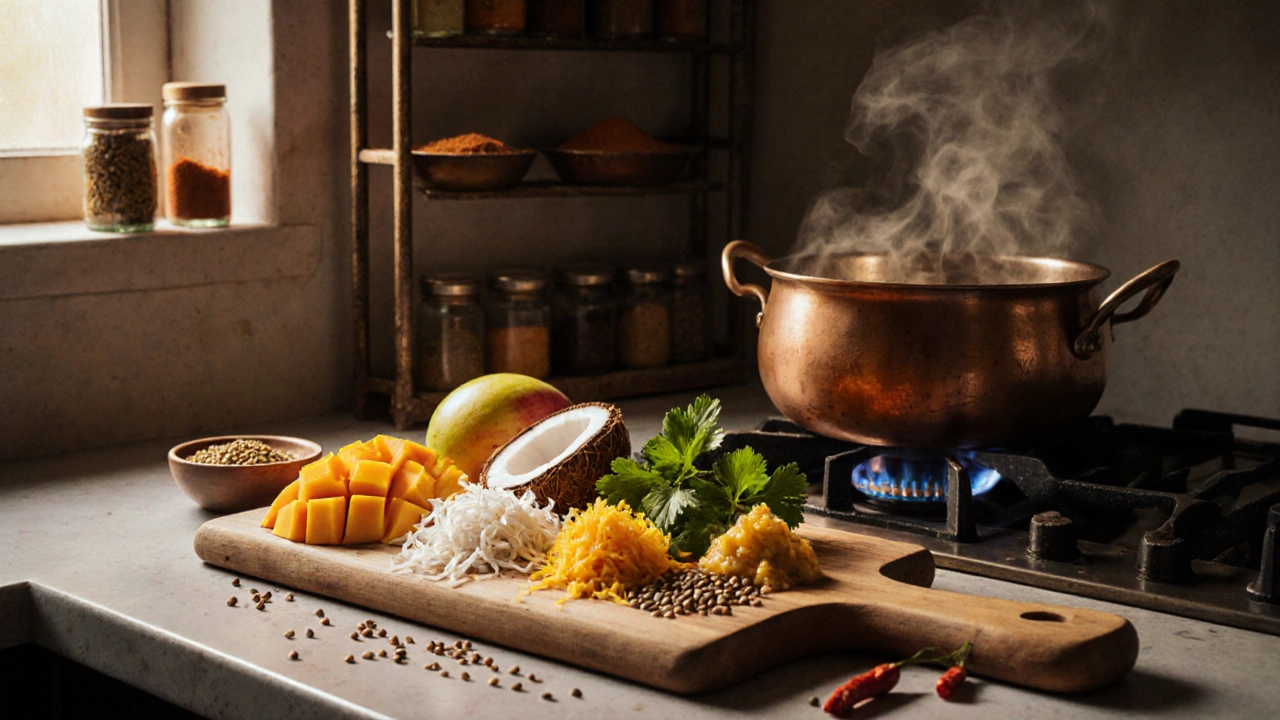Chutney Pairing Calculator
Find Your Perfect Chutney Pairing
Select a chutney type to see recommended pairings, flavor profile details, and storage tips.
Select a chutney type to see pairing suggestions
Choose from the options above to get personalized recommendations
Key Takeaways
- chutney definition: a versatile Indian condiment made by cooking fruit, veg, herbs, and spices.
- Roots trace back to ancient Indian Indian cuisine and were popularised during the British colonial era.
- Common varieties include mango, coconut, tamarind, and cilantro - each with a distinct flavor profile.
- Home‑made chutney is quick: blend, simmer, and store for weeks.
- Pairs well with breads, rice, grilled meats, and snacks.
When you hear the word “chutney,” you probably picture a sweet‑tangy mango jam on a sandwich or a spicy dip beside samosas. But what exactly is chutney? In simple terms, chutney is an Indian condiment that blends fruit, vegetables, herbs, spices, and often a touch of vinegar or sugar to create a sauce that can be sweet, sour, spicy, or a balanced mix of all three.
Historically, chutney dates back to the subcontinent’s ancient culinary tradition. The Sanskrit word cotta‑nyam referred to a kind of preparation that preserved seasonal produce with salt, oil, and spices. By the 16th century, Portuguese traders introduced vinegar‑based versions, and during the British Raj, the British adopted and tweaked these sauces into what we now recognise as “mango chutney” on Westminster tea tables.
How Chutney Differs From Other Condiments
Unlike a plain condiment such as ketchup or mustard, chutney is rarely a single‑ingredient puree. Its defining trait is the balance of flavors achieved through a spice blend that may include cumin, mustard seeds, fenugreek, and chili. The texture can range from chunky to smooth, and the preservation method varies - some recipes are cooked down to a jam‑like consistency, while others are fresh and uncooked, especially in South Indian kitchens.
Major Types of Chutney
Below are the most popular families, each highlighted with their headline ingredients and typical uses.
| Variety | Main Ingredient(s) | Flavor Profile | Typical Pairing | Sweetness Level |
|---|---|---|---|---|
| Mango Chutney | Mango, sugar, vinegar, ginger | Sweet‑tangy with mild heat | Curries, grilled meats, cheese boards | High |
| Coconut Chutney | Fresh coconut, green chilies, cilantro | Creamy, fresh, mildly spicy | Dosa, idli, rice bowls | Low |
| Tamarind Chutney | Tamarind pulp, jaggery, cumin, chili | Sour‑sweet with earthy spice | Samosas, chaat, fried snacks | Medium |
| Cilantro (Coriander) Chutney | Cilantro, mint, green chilies, lemon | Herby, bright, peppery | Grilled fish, kebabs, sandwiches | Low |

Deep‑Dive Into Four Star Varieties
Mango Chutney
Mango chutney is the poster child of Indian‑British fusion. Ripe mangoes are diced, then cooked with sugar, white vinegar, ginger, and a pinch of clove. The result is a glossy, spreadable jam that can accompany roast pork, chicken tikka, or a simple cheese toast. Nutritionally, mango provides vitamin A and C, while the vinegar adds a probiotic touch.
Coconut Chutney
This South Indian staple is made from freshly grated coconut, roasted chana dal, green chilies, and a tempering of mustard seeds and curry leaves. The tempering (known as tadka) adds a nutty crunch that contrasts the smooth coconut base. It’s dairy‑free and ideal for breakfast dishes like idli and dosa.
Tamarind Chutney
Tamarind chutney blends the sour pulp of tamarind with jaggery (unrefined cane sugar), roasted cumin, and red chili powder. The flavors are bold enough to cut through fried street foods such as papri‑chat or bhel puri, delivering that signature sweet‑sour tang.
Cilantro (Coriander) Chutney
Often called “green chutney,” this version uses fresh cilantro, mint leaves, green chilies, lemon juice, and a dash of ginger. It’s a quick blend that stays bright when served immediately; otherwise, it may darken, so prep it close to serving.
Step‑by‑Step: Simple Homemade Mango Chutney
- Gather 2 cups diced ripe mangoes, ½ cup sugar, ¼ cup white vinegar, 1 tsp grated ginger, a pinch of ground cloves, and a pinch of salt.
- Combine mango, sugar, and vinegar in a saucepan over medium heat.
- Stir until the sugar dissolves, then add ginger, cloves, and salt.
- Bring to a gentle boil, then reduce heat and simmer 20‑25 minutes, stirring occasionally, until the mixture thickens and the mango pieces soften.
- Remove from heat, let cool, then transfer to a sterilised jar. Store in the fridge for up to 4 weeks.
Tip: For extra depth, add a splash of dark rum or a few cardamom pods during the simmer.
Storage, Shelf Life, and Food Safety
Because most chutneys contain acid (vinegar or citrus) and sugar, they act as natural preservatives. Yet for safety:
- Keep refrigerated after opening; most will stay good 2‑4 weeks.
- For longer storage, process in a boiling water bath for 10 minutes to achieve a seal (like jam).
- If you see mold, off‑odor, or discoloration, discard immediately.

Creative Pairings and Serving Ideas
Think beyond the classic naan‑chutney duo. Here are a few fresh combos:
- Mango Chutney drizzled over grilled halloumi or paneer skewers.
- Coconut chutney spooned on a bowl of quinoa and roasted veggies for a vegan twist.
- Tamarind chutney mixed into a yogurt dip for an Indian‑style ranch.
- Green cilantro chutney as a sandwich spread with sliced cucumber and smoked turkey.
Common Troubleshooting
- Too watery: Increase simmer time or add a bit more sugar to thicken.
- Overly salty: Add extra fruit or a dash of honey to balance.
- Color darkening (green chutney): Add a squeeze of lemon juice right before serving; store in an airtight container.
What is the main difference between chutney and jam?
Jam is usually fruit plus sugar cooked to a spreadable consistency, while chutney mixes fruit, vegetables, herbs, spices, and an acid (vinegar or citrus). The spice blend gives chutney its savory edge.
Can I make chutney without cooking?
Yes. Fresh “green” chutneys like cilantro or mint versions are blended raw with lemon juice and chilies. They’re best served immediately.
Is chutney gluten‑free?
Traditional recipes are naturally gluten‑free. Just watch out for added thickeners or premade spice mixes that might contain wheat flour.
How long can homemade chutney last at room temperature?
If you’ve processed the jar in a boiling water bath and sealed it, it can keep for 3‑6 months in a cool, dark pantry. Once opened, refrigerate.
What spices are essential for a classic Indian chutney?
Cumin, mustard seeds, fenugreek, and chili powder are common. Regional versions may swap in coriander seeds, cardamom, or cloves.
Next Steps
Now that you know the chutney definition and its major styles, pick one variety and try the simple recipe. Adjust the heat, sweetness, or acidity to match your palate, then experiment with pairings. Keep a small notebook of your tweaks - that’s the fastest way to master this versatile condiment.
